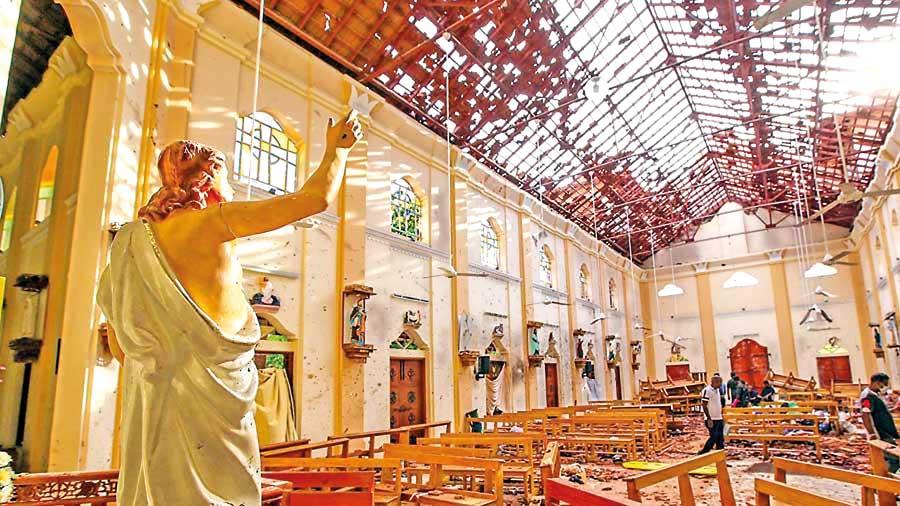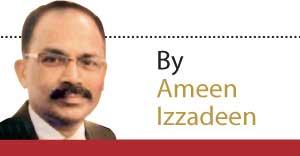21 Apr 2023 - {{hitsCtrl.values.hits}}

People seek answers to questions on the Easter Sunday attacks
As Sri Lanka marks the fourth anniversary of the Easter Sunday terror attacks today, the Catholic Church will stage this morning a human wall protest from Colombo to Negombo to express the people’s collective dissatisfaction over the lack of progress in investigations and prosecution.
express the people’s collective dissatisfaction over the lack of progress in investigations and prosecution.
The Church invited all Sri Lankans to join the protest, described as a campaign to seek truth and justice for the victims. Four years have passed since the barbaric attack on April 21, 2019, by a group of terrorists who turned Islam upside down to justify their murderous mission. Hundreds of suspects have been arrested and interrogated. Commissions have been appointed and reports produced. Yet, apart from a Supreme Court ruling on a series of fundamental rights petitions, justice remains largely elusive and the truth suppressed.
In January this year, the Supreme Court ruled that the then President Maithripala Sirisena, the then Defence Secretary Hemasiri Fernando, the then Police Chief Pujith Jayasundera, the then State Intelligence Chief Nilantha Jayawardena, and the then National Intelligence Director Sisira Mendis failed to prevent the Easter Sunday bombings despite warnings from India’s intelligence agency weeks before the attacks.
More than 270 people died in the orchestrated attacks targeting churches and tourist hotels. The seven-judge Supreme Court bench held the former president and the four top officials in charge of the country’s security accountable because their negligence led to one of the worst terror attacks in the country’s history. Sirisena was ordered to pay Rs. 100 million as compensation, while the other four respondents were ordered to pay a total of Rs. 210 million for culpable negligence.
A private plaint against the former President and the other officials was also filed in a magistrate court, but the case is now enmeshed in an appeal process, raising questions about the manner in which the wheels of justice turn in Sri Lanka.
A pertinent question arises from the recent arraignment of former United States President Donald Trump before a criminal court on charges of falsifying accounts with regard to a hush payment he made to a porn star mistress. That he was a former president did not prevent investigators from producing him in court. We ask: Why is it not happening in Sri Lanka?
The two cases in the two countries may be poles apart, but principles of justice, whether in Sri Lanka or the United States, are universal and engrained in the character of every person who knows to differentiate right from wrong and then stands up for what is right.
But in the people’s court, the ruling appears to be that the Easter Sunday incident was politically motivated. Conspiracy theories abound, and they gain credibility with each passing day while investigators are stuck in a pool of super glue.
Among those who said the Easter Attack was one big conspiracy was the then Attorney General Dappula de Livera. He refused to give a statement to the CID this week.
Visiting the bombed St. Anthony’s Church in Colombo’s Kochchikade area soon after the attack, Cardinal Malcolm Ranjith said he suspected a hidden hand behind the attacks and called on the Catholics to remain calm and not to harm a single Muslim.
Not all guesses about the attack’s masterminds can be dismissed as conspiracy theories. The smoking gun becomes visible when answers are not forthcoming as to who, what, and why of the attacks.
Analysts often zero in on the hidden hand behind a crime, a terror attack, or even a war by asking the crucial question of who stands to gain from the outcome.
The terror group al-Qaeda was accused of carrying out the 9/11 attacks, and several of the top al-Qaeda operatives were arrested and detained. But who benefited from the attack?
The attack offered a launching pad for the United States to roll out a global project aimed at re-establishing its position as the world’s dominant power. It enabled the US to invade Afghanistan and Iraq, set up new military bases in the newly created Central Asia, and get involved in wars in Libya, Syria, and other countries, including the Philippines, where Muslim separatists in the Mindanao region were fighting the government forces.
Recently, a US court declaration filed by Don Canestraro, a lead investigator for the Office of Military Commissions, revealed that two of the 9/11 hijackers were part of a joint CIA-Saudi intelligence op. The court papers also claim that the two were being monitored by the CIA’s Alec Station, a unit formed to track down al-Qaeda leader Osama bin Laden.
The declaration also claims that the two soon-to-be hijackers -- Nawaf al-Hazmi and Khalid al-Mihdhar -- had a meeting in Kuala Lumpur with some al-Qaeda members and took some important decisions on the 9/11 attacks. Malaysian intelligence officers secretly videotaped the meeting following a tip-off from the CIA. The two terrorists had multiple-entry visas to the US.
When an FBI representative in the Alec Station wanted to alert the FBI and make arrangements to arrest the two terrorists, the CIA representatives in the unit prevented him from doing so. An FBI agent was quoted as saying in the court papers that the CIA helped a Saudi intelligence agent identified as Bayoumi open a bank account for the two hijackers. They also got them an apartment on lease.
As the 9/11 mystery continues, what is found in the court document is just a trickle. Much more information is kept out of people’s reach, with reports of the 9/11 commissions being released only after redaction. The US authorities exercise information control on the pretext of national interest.
The nexus between secret units within intelligence services and terrorists gives rise to the Orwellian question: Is terrorism real or fake? Even the dreaded ISIS could be a product of an intelligence lab operated by an intelligence agency. The plans are so sophisticated that the terrorist being handled does not know he is being handled. With holy idiots in abundance, forming an Islamic terror group is no major task.
Was Sri Lanka’s Easter Sunday terrorist group a similar lab product of a domestic or foreign intelligence agency? Infiltrating terrorist groups is a basic tactic any intelligence agency worth its salt resorts to.
Just as some of the 9/11 hijackers were known to the CIA, Easter Sunday terror leader Zahran Hashim, who blew himself up at the newly opened Shangri La Hotel in Colombo, had been known to Sri Lanka’s intelligence operators for years. He was in the pay of military intelligence during the separatist war. How did the terrorists gain access to such large amounts of explosives and bomb-making technology? Why did the investigators not make use of early leads, including a dry run in the form of a motorcycle bomb blast a few days before Easter Sunday, to prevent the attacks? These are some of the serious questions the survivors of the attack, the relatives of the victims, and the people of Sri Lanka ask.
With no credible answers to these questions to be found, unravelling the hidden hands behind the Easter Sunday attacks will be an exercise in futility.
04 Jan 2025 5 hours ago
04 Jan 2025 5 hours ago
04 Jan 2025 6 hours ago
04 Jan 2025 6 hours ago
04 Jan 2025 7 hours ago